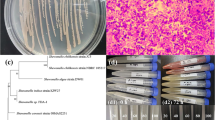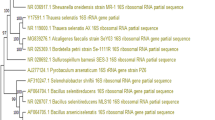Abstract
Environmental contamination by Te and Se oxyanions has become a serious concern, with the search for green, ecologically friendly methods for removal gaining ground. Bacteria capable of reducing these highly toxic compounds to a virtually non-toxic elemental form could provide a solution. In this study, four strains of bacteria with potential for bioremediation of Te and Se oxyanions were investigated. Under aerobic conditions over 48 h, Erythromicrobium ramosum, strain E5 removed 244 µg/ml tellurite and 98 µg/ml selenite, Erythromonas ursincola, KR99 203 µg/ml tellurite and 100 µg/ml selenite, AV-Te-18 98 µg/ml tellurite and 103 µg/ml selenite and ER-V-8 93 µg/ml tellurite and 103 µg/ml selenite. In the absence of oxygen, AV-Te-18 and ER-V-8 removed 10 µg/ml tellurite after 24 and 48 h, respectively and 46 and 25 µg/ml selenite, respectively, over 48 h. ER-V-8 removed 14 µg/ml selenate after 5 days. This highlights the great potential of these microbes for use in bioremediation.



Similar content being viewed by others
References
Arenas F, Pugin B, Henriquez N, Areanas-Salinas M, Diaz-Vasquez W, Pozo M, Munoz C, Chasteen T, Perez-Donoso J, Vasquez C (2014) Isolation, identification and characterization of highly tellurite-resistant, tellurite-reducing bacteria from Antartica. Polar Sci 8:40–52
Bajaj M, Winter J (2014) Se (IV) triggers faster Te (IV) reduction by soil isolates of heterotrophic aerobic bacteria: formation of extracellular SeTe nanospheres. Microb Cell Fact 13:168–178
Bhatnagar I, Kim S-K (2010) Immense essence of excellence: marine microbial bioactive compounds. Mar Drugs 8(10):2673–2701
Bonificio W, Clarke D (2014) Bacterial recovery and recycling of tellurium from tellurium-containing compounds by Pseudoalteromonas sp. EPR3. J Appl Microbiol 117(5):1293–1304
Borghese R, Borsetti F, Foladori P, Ziglio G, Zannoni D (2004) Effects of the metalloid oxyanion tellurite (TeO3 2–) on growth characteristics of the phototrophic bacterium Rhodobacter capsulatus. Appl Environ Microbiol 70(11):6595–6602
Bradford M (1976) A rapid and sensitive method for the quantitation of microgram quantities of protein utilizing the principle of protein-dye binding. Anal Biochem 72:248–254
Cantafio A, Hagen K, Lewis G, Bledsoe T, Nunan K, Macy J (1996) Pilot-scale selenium bioremediation of San Joaquin drainage water with Thauera selenatis. Appl Environ Microbiol 62(9):3298–3303
Csotonyi J, Stackebrandt E, Yurkov V (2006) Anaerobic respiration on tellurate and other metalloids in bacteria from hydrothermal vent fields in the eastern Pacific Ocean. Appl Environ Microbiol 72(7):4950–4956
Desai G, Paul J (1977) Simultaneous spectrophotometric determination of tetravalent and hexavalent selenium. Microchem J 22(2):176–181
Dogan N, Kantar C, Gulcan S, Dodge C, Yilmaz B, Mazmanci M (2011) Chromium(VI) bioremoval by Pseudomonas bacteria: role of microbial exudates for natural attenuation and biotreatment of Cr(VI) contamination. Environ Sci Technol 45(6):2278–2285
Elwakeel K, Atia A, Donia A (2009) Removal of Mo(VI) as oxoanions from aqueous solutions using chemically modified magnetic chitosan resins. Hydrometallurgy 97(1–2):21–28
Epelde L, Lanzen A, Blanco F, Urich T, Garbisu C (2015) Adaptation of soil microbial community structure and function to chronic metal contamination at an abandoned Pb-Zn mine. FEMS Microbiol Ecol 91(1):1–11
Fujii R, Deverel S, Hatfield D (1988) Distribution of selenium in soils of agricultural fields, western San Joaquin Valley, California. Soil Sci Soc Am J 52(5):1274–1283
Gadd G (2010) Metals, minerals and microbes: geomicrobiology and bioremediation. Microbiology 156:609–643
Hunter W, Kuykendall D (2005) Removing selenite from groundwater with an in situ biobarrier: laboratory studies. Curr Microbiol 50:145–150
Jadhav J, Kalyani D, Telke A, Phugare S, Govindwar S (2010) Evaluation of the efficacy of a bacterial consortium for the removal of color, reduction of heavy metals, and toxicity from textile dye effluent. Bioresour Technol 101(1):165–173
Javed S, Sarwar A, Tassawar M (2016) Conversion of selenite to elemental selenium by indigenous bacteria isolated from polluted areas. Chem Speciat Bioavailab 27(4):162–168
Kim Y, Kim C, Choi I, Rengaraj S, Yi J (2004) Arsenic removal using mesoporous alumina prepared via a templating method. Environ Sci Tech 38:924–931
Kim D-H, Kanaly R, Hur H-G (2012) Biological accumulation of tellurium nanorod structures via reduction of tellurite by Shewanella oneidensis MR-1. Bioresour Technol 125:127–131
Li H, Feng Y, Zou X, Luo X (2009) Study on microbial reduction of vanadium metallurgical waste water. Hydrometallurgy 99:13–17
Li B, Liu N, Li Y, Jing W, Fan J, Li D, Zhang L, Zhang X, Zhang Z, Wang L (2014a) Reduction of selenite to red elemental selenium by Rhodopseudomonas palustris strain N. PLoS One 9(4):e95955
Li D-B, Cheng Y-Y, Wu C, Li W-W, Li N, Yang Z-C, Tong Z-H, Yu H-Q (2014b) Selenite reduction by Shewanella oneidensis MR-1 is mediated by fumarate reductase in periplasm. Sci Rep 4:3735. https://doi.org/10.1038/srep03735
Luek A, Brock C, Rowan D, Rasmussen J (2014) A simplified anaerobic bioreactor for the treatment of selenium-laden discharges from non-acidic, end-pit lakes. Mine Water Environ 33:295–306
Macy J, Lawson S, DeMoll-Decker H (1993) Bioremediation of selenium oxyanions in San Joaquin drainage water using Thauera selenatis in a biological reactor system. Appl Microbiol Biotechnol 40:588–594
Maltman C, Yurkov V (2014) The impact of tellurite on highly resistant marine bacteria and strategies for its reduction. Int J Environ Eng Nat Resour 1(3):109–119
Maltman C, Yurkov V (2015) The effect of tellurite on highly resistant freshwater aerobic anoxygenic phototrophs and their strategies for reduction. Microorganisms 3(4):826–838
Maltman C, Piercey-Normore M, Yurkov V (2015) Tellurite-, tellurate-, and selenite-based anaerobic respiration by strain CM-3 isolated from gold mine tailings. Extremophiles 19(5):1013–1019
Maltman C, Walter G, Yurkov V (2016) A diverse community of metal(loid) oxide respiring bacteria are associated with tube worms in the vicinity of the Juan de Fuca Ridge black smoker field. PLoS One 11(2):e0149812
Maltman C, Donald L, Yurkov V (2017a) Two distinct periplasmic enzymes are responsible for tellurite/tellurate and selenite reduction by strain ER-Te-48 associated with the deep sea hydrothermal vent tube worms at the Juan de Fuca Ridge black smokers. Arch Microbiol 199(8):1113–1120
Maltman C, Donald L, Yurkov V (2017b) Tellurite and tellurate reduction by the aerobic anoxygenic phototroph Erythromonas ursincola, strain KR99 is carried out by a novel membrane associated enzyme. Microorganisms 5(20):https://doi.org/10.3390/microorganisms5020020
Molina R, Burra R, Perez-Donoso J, Elias A, Munoz C, Montes R, Chasteen T, Vasquez C (2010) Simple, fast, and sensitive method for quantification of tellurite in culture media. Appl Environ Microbiol 76(14):4901–4904
Moore M, Kaplan S (1992) Identification of intrinsic high-level resistance to rare-earth oxides and oxyanions in members of the class Proteobacteria: characterization of tellurite, selenite, and rhodium sesquioxide reduction in Rhodobacter sphaeroides. J Bacteriol 174(5):1505–1514
Pieper D, Reineke W (2000) Engineering bacteria for bioremediation. Curr Opin Biotechnol 11:262–270
Prakash V, Rao N, Bhatnagar A (2001) Linear optical properties of niobium-based tellurite glasses. Solid State Commun 119:39–44
Rajwade J, Paknikar K (2003) Bioreduction of tellurite to elemental tellurium by Pseudomonas mendocina MCM B-180 and its practical application. Hydrometallurgy 71:243–248
Ramon-Ruiz A, Field J, Wilkening J (2016) Recovery of elemental tellurium nanoparticles by the reduction of tellurium oxyanions in a methanogenic microbial consortium. Environ Sci Technol 50(3):1492–1500
Rathgeber C, Yurkova N, Stackebrandt E, Beatty T, Yurkov V (2002) Isolation of tellurite- and selenite-resistant bacteria from hydrothermal vents of the Juan de Fuca Ridge in the Pacific ocean. Appl Environ Microbiol 68(9):4613–4622
Ruggiero C, Boukhalfa H, Forsythe J, Lack J, Hersman L, Nue M (2005) Actinide and metal toxicity to prospective bioremediation bacteria. Environ Microbiol 7(1):88–97
Shah K, Nongkynrih J (2007) Metal hyperaccumulation and bioremediation. Biol Plant 51(4):618–634
Soudi M, Ghazvini P, Khajeh K, Gharavi S (2009) Bioprocessing of seleno-oxyanions and tellurite in a novel Bacillus sp. strain STG-83: a solution to removal of toxic oxyanions in presence of nitrate. J Hazard Mater 165:71–77
Staicu L, van Hullecusch E, Lens P (2017) Industrial selenium pollution: wastewaters and physical-chemical treatment technologies. In: van Hullebusch E (ed) Bioremediation of selenium contaminated wastewater. Springer, Cham
Wasi S, Tabrez S, Ahmad M (2013) Use of Pseudomonas spp. for the bioremediation of environmental pollutants: a review. Environ Monit Assess 185(10):8147–8155
Yang J, Tang Y, Yang K, Rouff A, Elzinga E, Hyang J (2014) Leaching characteristics of vanadium in mine tailings and soils near a vanadium titanomagnetite mining site. J Hazard Mater 264:498–504
Yong Y-C, Zhong J-J (2010) Recent advances in biodegradation in China: new microorganisms and pathways, biodegradation engineering, and bioenergy from pollutant biodegradation. Process Biochem 45(12):1937–1943
Yurkov V, Beatty T (1998) Aerobic anoxygenic phototrophic bacteria. Microbiol Mol Biol Rev 62(3):695–724
Yurkov V, Stackebrandt E, Holmes A, Fuerst J, Hugenholtz P, Golecki J, Gad’on N, Gorlenko V, Kompantseva E, Drews G (1994) Phylogenetic positions of novel aerobic bacteriochlorophyll a-containing bacteria and description of Roseococcus thiosulfatophilus gen. nov., sp. nov., Erythromicrobium ramosum gen. nov., sp. nov., and Erythrobacter litoralis sp. nov. Int J Syst Bacteriol 44:427–434
Yurkov V, Jappe J, Vermeglio A (1996) Tellurite resistance and reduction by obligately aerobic photosynthetic bacteria. Appl Environ Microbiol 62(11):4195–4198
Yurkov V, Stackebrandt E, Buss O, Vermeglio A, Gorlenko V, Beatty T (1997) Reorganization of the genus Erythromicrobium: description of “Erythromicrobium sibiricum” as Sandaracinobacter sibiricus gen. nov., sp. Nov., and of “Erythromicrobium ursincola” as Erythromonas ursincola gen. nov., sp. nov. Int J Syst Bacteriol 47(4):1172–1178
Yurkov V, Krieger S, Stackebrandt E, Beatty T (1999) Citromicrobium bathyomarinum, a novel aerobic bacterium isolated from deep-sea hydrothermal vent plume waters that contains photosynthetic pigment–protein complexes. J Bacteriol 181(15):4517–4525
Acknowledgements
This work was supported by a National Science and Engineering Research Council of Canada Discovery grant held by V. Yurkov.
Author information
Authors and Affiliations
Corresponding author
Additional information
Communicated by Erko Stackebrandt.
Rights and permissions
About this article
Cite this article
Maltman, C., Yurkov, V. Bioremediation potential of bacteria able to reduce high levels of selenium and tellurium oxyanions. Arch Microbiol 200, 1411–1417 (2018). https://doi.org/10.1007/s00203-018-1555-6
Received:
Revised:
Accepted:
Published:
Issue Date:
DOI: https://doi.org/10.1007/s00203-018-1555-6




